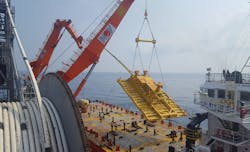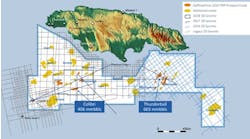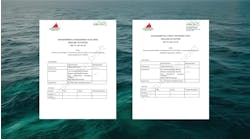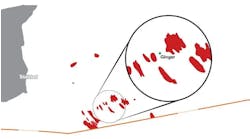Jessica Tippee • Houston
McDermott highlights Vashishta and S1 subsea installation campaign
ONGC recently achieved first gas from the deepwater Vashishta and S1 development project in the Krishna-Godavari basin off eastern India. The Vashishta field lies in water depths between 500 and 700 m (1,600 and 2,300 ft), about 31 to 35 km (19 to 22 mi) from the Amalapuram coast. The field is estimated to produce 9.56 bcm over a period of nine years with peak production reaching 3.55 MMscm/d during the first five years. The S1 field is in water depths between 250 and 600 m (800 and 2,000 ft), about 26 to 29 km (16 to 18 mi) from the Amalapuram coast. It is expected to deliver 6.22 bcm over a period of eight years with a peak production of 2.2 MMcm/d for the first five years.
On ONGC’s Vashishta project, the first end pipeline end termination is lifted from the supply boat by theNO 105. This is the largest PLET that the vessel has ever installed, weighing 88 tons, including a 23-m (75-ft) long stress joint. (Courtesy McDermott)
In December 2015, McDermott and consortium partner LTHE, a wholly owned subsidiary of Larsen & Toubro Ltd., received an engineering, procurement, construction, and installation (EPCI) contract for the project’s subsea infrastructure.
The consortium was responsible for the engineering, supply, and installation of a series of pipeline end terminations (PLETs) and in-line tee structures (ILTs), a pipeline end manifold structure (PLEM), rigid jumpers, and about 50 km (31 mi) of umbilicals. The pipeline scope included 93 km (58 mi) of 14-in. dual rigid pipelines extending from the shallow water shore line to a maximum water depth of 700 m (2,300 ft).
Ben Delves, McDermott’s Vashishta Project Director, said: “Engineering design for the Vashishta project was no easy feat due to the iterative nature of the design process which had to reconcile many factors such as soil conditions, jumper/spool loads, connector capacities, in-place environmental loads, pipeline expansion loads, installation weather limitations, vessel envelope constraints, and mission equipment constraints.”
Typical weights for Vashishta PLETs and ILTs ranged from 35 to 85 metric tons (27 to 93 tons) and the PLEM weight was 200 metric tons (220 tons).
“A combination of soft soils and the significant weight of permanent equipment has contributed to some large structures,” said Delves, “which made the interfaces with the installation vessel challenging.”
The installation of the subsea infrastructure was particularly challenging, according to McDermott, as the company only had four months out of the year to work offshore before the monsoon season hit the field with bad weather and strong sea undercurrents.
During the installation phase, McDermott deployed itsDerrick Barge 30, Lay Vessel North Ocean 105, and North Ocean 102. The company also deployed its portable spoolbase at the LTHE base in Kattupalli, India, to fasttrack the production of pipeline stalk for loading onto the installation vessels.
Subsea equipment JIP starts next phase
Wood has launched the next phase of an initiative to improve understanding of the reliability of subsea equipment applied offshore Australia. The company is leading the Subsea Equipment Australian Reliability Joint Industry Project (SEAR JIP), which has support from operators including Chevron Australia, ConocoPhillips, Quadrant, and Woodside. Their goals are to enhance subsea equipment design and reduce the requirement for costly and time-consuming interventions in the offshore warm water environment.
For the latest phase, the focus will be on:
• Continuing the collaboration effort across a large group of Australian subsea system operators
• Continuing to collect reliability data for subsea equipment for operations offshore Australia
• Expanding a marine fouling subsea test program, with additional laboratories in northern Australia to assess innovative coatings, materials, and technologies and their ability to withstand calcareous deposition and plant/animal growth
• Establish marine fouling cleaning best practice and identify opportunities to improve the effectiveness of existing practices
• Evaluate the performance of umbilicals and identify best practice remediation.
Adriana Botto, Wood’s project manager for the SEAR JIP, said: “Enhancing the design of subsea equipment to mitigate issues and reduce the requirement for intervention was a key focus in the initial phases of the SEAR JIP.
“Through our collaborative work we have taken significant strides forward in identifying the root cause of equipment performance issues, so that they can be designed out by vendors in the future.
“This phase of the project will build on our work to date, with a key focus on improving understanding of subsea equipment reliability issues. The long-term value of the project will be a step change in industry practice and performance, with lessons learned shared across operators, vendors, and research institutions.”
Xodus reviews scope for two Apache North Sea tiebacks
Apache Corp. has contracted Xodus Group to conduct studies for two subsea tiebacks in the UK central North Sea.
One involves initially a conceptual assessment of options under consideration for the 2016 Storr discovery in the Beryl area before progressing to front-end engineering design for the selected option. The scope includes subsea pipeline design, flow assurance, materials and corrosion engineering coatings selection, and structural and environmental support.
Xodus is also performing subsea engineering for the Seagull oil field, 80 km (50 mi) south of Apache’s Forties complex in block 22/29c, which was reportedly under review for a tieback to the BP-operated ETAP complex.
Previously Xodus completed the concept selection phase for the development. As with Storr, the scope includes pipeline engineering, materials and corrosion support, manifolds and structures engineering, and environmental impact support.





